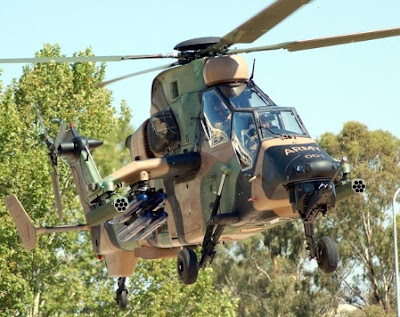24 Mei 2012
The Heron 1
UAV (above) will replace the Searcher-class UAV that has been in service since
1994. (photo : Sing Mindef)
The Republic
of Singapore Air Force (RSAF) enhanced the intelligence, surveillance and
reconnaissance (ISR) capabilities of the 3rd Generation Singapore Armed Forces
(SAF) as it inaugurated the Heron 1 Unmanned Aerial Vehicle (UAV) into 119
Squadron (SQN) on 23 May.
Minister for
Defence Dr Ng Eng Hen, who officiated at the inauguration ceremony at Murai
Camp, pointed out that the SAF's vision for UAVs started as early as the 70s,
quoting Singapore's first Defence Minister Dr Goh Keng Swee: "For our kind
of terrain, we must have Remotely Piloted Vehicles. We must see the enemy without
being seen."
"The
UAVs have realised the vision of SAF’s founding pioneers but only through
continued investments to develop this capability," he added. "As a
result, the SAF today is an advanced user of UAVs... (which) are used routinely
in exercises as well as in operations."
Highlighting
the importance of the UAV in transforming the SAF into a modern and effective
fighting force, Dr Ng noted that the Heron 1 UAV will "provide our
commanders, planners and soldiers on the ground (with) better situational
awareness to make timely and informed decisions to engage the adversary
decisively and complete their missions effectively".
Featuring
state-of-the-art avionics, detection capabilities and communication systems,
the Heron 1 UAV will replace the Searcher-class UAV that has been in service
since 1994.
Compared to
its predecessor, which has a maximum operating altitude of 10,000 feet, the
Heron 1 UAV can fly twice as high at 20,000 feet. It has a flight endurance of
over 24 hours, more than three times that of the Searcher UAV (eight hours).
Furthermore, the Heron 1 UAV has a maximum operating range of 200km, double
that of the Searcher-class.
The advanced
UAV is also equipped with an Automatic Take Off and Landing (ATOL) system,
which allows a desired flight route to be scheduled prior to launch, and is
able to return to a pre-designated recovery point at the end of its mission.
This enhances the timeliness in which information is disseminated, as UAV
operators can focus on collecting and processing information instead of flight
operations.
Lieutenant-Colonel
(LTC) Kenneth Won, Commanding Officer of 119 SQN, was proud of his squadron's
achievements in being the first UAV squadron to operate the Heron 1.
"It's
not always been smooth-sailing; there have been a lot of challenges along the
way but we've achieved a key milestone in bringing in this new capability. More
importantly, we have built a team in which the operational and logistics crew
are strongly integrated."
The Heron 1
UAV (right) will replace the Searcher-class UAV (left) that has been in service
since 1994. (photo : Sing Mindef)
He noted
that the Heron 1 UAV's advanced surveillance and reconnaissance capabilities
will provide the RSAF with "sharper eyes" in the skies, which will be
an important component in the complex battle environment of the future.
Officer
Commanding of 119 SQN and UAV Pilot Major (MAJ) Low Jun Horng commented on how
the improved systems of the Heron 1 UAV have made it more mission-effective:
"The Heron 1 provides us with an enhanced situational awareness of the
battlefield as it has better detection capability and three times the flight
endurance of the Searcher UAV... It also gives us the ability to see things in
colour as compared to the monochrome video system of the Searcher UAV. This
allows us to detect targets that could not have been detected previously with
the Searcher."
Paying
tribute to the personnel of 119 SQN, Dr Ng said: "The advanced
surveillance and reconnaissance capabilities of the Heron 1 UAV are, however,
only as effective as the people who operate and maintain them. I would like
therefore to commend all of you, the men and women of 119 Squadron, who have
worked tirelessly in the last year to ready the Heron 1 UAV systems to support
the SAF's operations."
Senior
Parliamentary Secretary for Defence and National Development Dr Mohamad Maliki
Bin Osman, Chief of Air Force Major-General Ng Chee Meng and senior officers
from the SAF were also present at the ceremony.













.jpg)
















